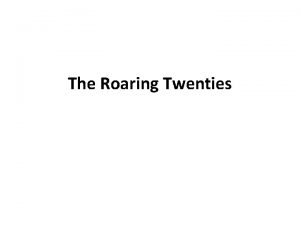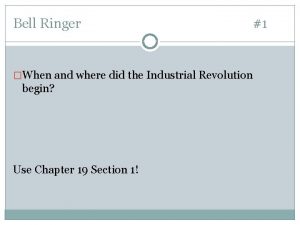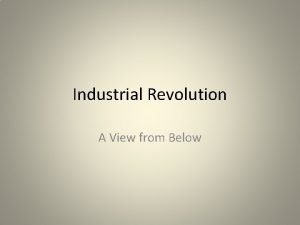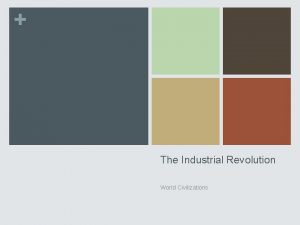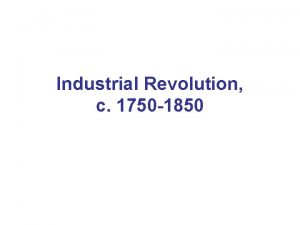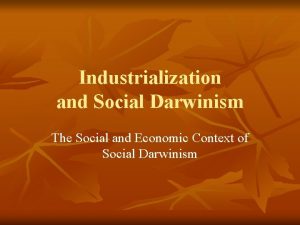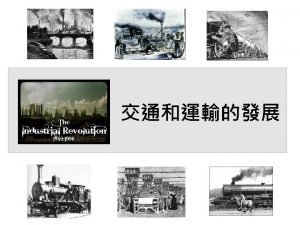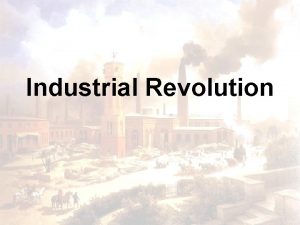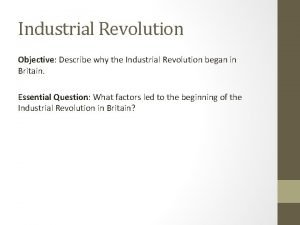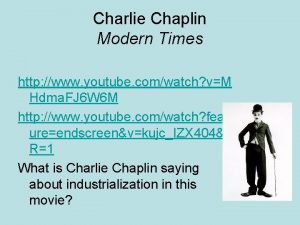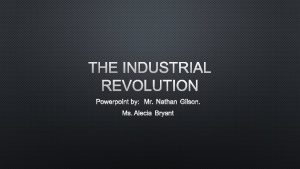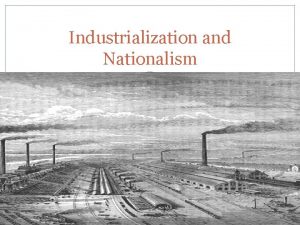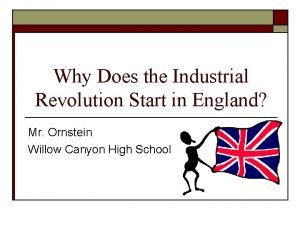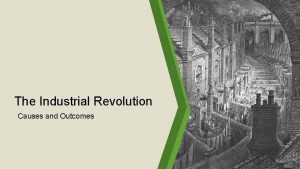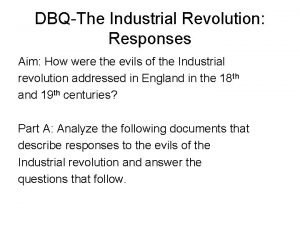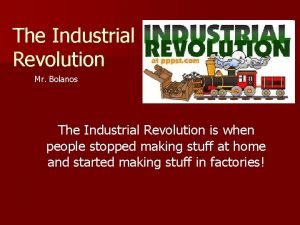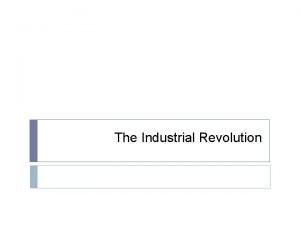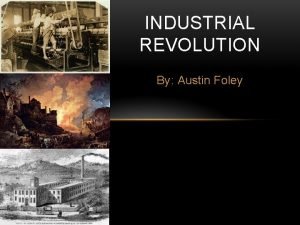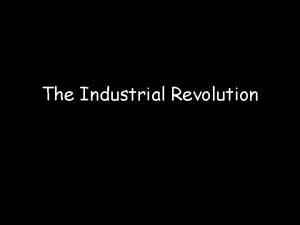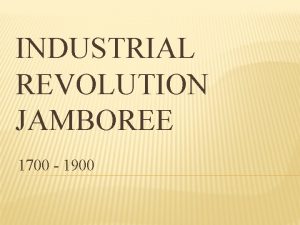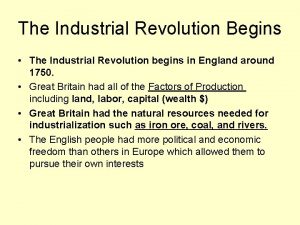Aim Were the outcomes of the Industrial Revolution
























- Slides: 24

Aim: Were the outcomes of the Industrial Revolution more positive or negative? 1750 – 1900

I A New Social Order A) As a result of the Industrial Revolution, a new social class structure emerged. The aristocracy (wealthy landowning families) still existed but lost some power to the new middle class. B) The middle class (bourgeoisie in French) included business owners, industrialists, and capitalists. C) The lowest class was the working class who labored in mines, factories, and the homes of the aristocracy and middle class.

II Urbanization A) Urbanization increased rapidly; workers moved from rural farmland to cities overcrowded housing, and unsanitary living conditions. In cities many poor laborers lived in tenements (crowded apartment buildings). Conditions gradually improved by the late 19 th century, due to labor reforms and the rise of trade unions. Population of Selected British Cities (18011891) Town 1801 1861 1891 Birmingham 74, 000 296, 000 523, 000 Leeds 53, 000 207, 000 429, 000 Liverpool 80, 000 444, 000 704, 000 Manchester 90, 000 339, 000 645, 000

III Luddites “Luddites" are people opposed to technological change. The term is derived from a group of early 19 th century English workers who attacked factories and destroyed machinery as a means of protest.

Child Labor A) "Parish apprentice children" were orphans who were fed & housed in exchange for work in factories (without being paid wages). B) “Free Labor Children” With urbanization, low class families sent their children to work in factories. C) Children were ideal employees due to obedience, small hands and bodies that were better for certain tasks, and cheap (paid 10 – 20 % of a man's wage). "I have seen a little boy, only this winter, who works in the mill, and who lives within 200 or 300 yards of my own door; he is not yet 6 years old, and I have seen him, when he had a few coppers in his pocket, go to a beer shop, call for a glass of ale, and drink as boldly as any full -grown man, cursing and swearing. " - Abraham Whitehead, a cloth merchant from Holmfirth who joined the campaign for factory legislation, told a parliamentary committee in 1832 A hurrier and two thrusters heaving a corf full of coal as depicted in the 1853 book The White Slaves of England by J. Cobden

Child Labor Continued… "We went to the mill at five in the morning. We worked until dinner time and then to nine or ten at night; on Saturday it could be till eleven and often till twelve at night. We were sent to clean the machinery on the Sunday. " - Man interviewed who had worked in a mill as a child (1849)

Child Coal Miners, 1907

“Match” Girls “Match girls worked long hours in the factories (usually from 6 AM to 6 PM) with only two short breaks. They were not allowed to talk or even sit down while they worked (otherwise they would be fined or fired). The girls only made 4 shillings a day, but they were also heavily fined if they dropped a match, talked to each other, sat down, arrived late, or went to the bathroom without permission. Beatings were not uncommon at the factories as well. ” http: //britishindustrialrevolution. weebly. com/childlabor-match-girls. html

Excerpt from "How the Other Half Lives" Jacob Ris 1890. In the late 1880 s, Jacob Riis, himself a Danish immigrant, began writing articles for the New York Sun that described the realities of life in New York City's slums. Riis was one of the first reporters to use flash photography, allowing him to take candid photos of living conditions among the urban poor. Riis's work helped spark a new approach to reporting called "muckraking" that eventually led to the Progressive Era reform movements to improve these conditions. “Men, women and children work together seven days in the week in these cheerless tenements to make a living for the family, from the break of day till far into the night. . I have in mind an alley— inlet rather to a row of rear tenements— is either two or four feet wide according as the wall of the crazy old building that gives on it bulges out or in. I tried to count the children that swarmed there, but could not. Sometimes I have doubted that anybody knows just how many there about. Bodies of drowned children turn up in the rivers right along in summer whom no one seems to know anything about. When last spring some workmen, while moving a pile of lumber on a North River pier, found under the last plank the body of a little lad crushed to death, no one had missed a boy, though his parents afterward turned up. The truant officer assuredly does not know, though he spends his life trying to find out, somewhat illogically, perhaps, since the department that employs him admits that thousands of poor children are crowded out of the schools year by year for want of room. . ”

Tenement NYC 1890 by Jacob Riis

IV New Ideologies Adam Smith 1723 - 1790 Wrote “The Wealth of Nations” Thomas Malthus 1766 – 1834 British economist. John Stuart Mill 1806 - 1873 Argued for utilitarianism: the government should get involved to help the working class. Argued for free Argued that increases in market/capitalism based population will lead to on supply and demand. not enough food to feed the world. Everyone is entitled to happiness, but only if the happiness of one social class does not jeopardize the happiness of another. Laissez-faire: Government stays out of the economy. Encouraged suffrage for working class and women.

Adam Smith “If any branch of trade, or any division of labor, be advantageous to the public, the freer… the competition, it will always be the more so. ”

Thomas Malthus “The superior power of population cannot be checked without producing misery or vice. ” “Population, when unchecked, goes on doubling itself every 25 years or increases in a geometrical ratio. ” - Thomas Malthus

“Malthus, the false prophet” May 15 th 2008, The Economist … Malthus first set out his ideas in 1798 in “An Essay on the Principle of Population”. . . Whereas the natural tendency was for populations to grow without end, food supply would run up against the limit of finite land. As a result… higher mortality caused by famine, disease and war were necessary to bring the number of people back in line with the capacity to feed them. In a second edition published in 1803, Malthus softened his original harsh message by introducing the idea of moral restraint. . . If couples married late and had fewer children, population growth could be sufficiently arrested for agriculture to cope… But the industrial revolution, which had already begun in Britain, was transforming the long-term outlook for economic growth. Economies were starting to expand faster than their populations, bringing about a sustained improvement in living standards. Far from food running out, as Malthus had feared, it became abundant as trade expanded and lowcost agricultural producers like Argentina and Australia joined the world economy. . . His assumption that populations would carry on growing in times of plenty turned out to be false. Starting in Europe, as economic development brought greater prosperity, both birth and death rates dropped and population growth eventually started to slow. . .

John Stuart Mill “Both in England on the Continent a graduated property tax has been advocated, on the avowed ground that the state should use… taxation as a means of mitigating the inequalities of wealth… To tax the larger incomes at a higher percentage than the smaller is to lay a tax on industry and economy; to impose a penalty on people for having worked harder and saved more than their neighbors. It is not the fortunes which are earned, but those which are unearned, that it is for the public good to place under limitation. ” Principles of Political Economy (1848), Book V, Chapter II

V Reform: Unions! A) The rise of labor unions can be linked to Europe (18 th century) and in North America (19 th century). They used collective bargaining for more rights such as more pay and better working conditions. B) The imbalance of power between industry and laborers made the first few labor movements, such as the National Labor Union, limited in their success. The largest union at this time was the Order of the Knights of St. Crispin that represented the shoe and printing industry. They sought to decrease the trend toward mechanized production that was replacing cobblers and printers. C) Labor unions had greater influence when the American Federation of Labor sought to focus on improving wages and the working conditions of its members.

Unions! International Ladies’ Garment Workers’ Union protest after the Triangle Shirtwaist factory fire, which cost 146 workers their lives and led to new laws for better working conditions, New York, 1911. Samuel Gompers Papers (Editorial Project).

VI Reform: Public Education in Britain ü Before the 1800 s, education was not free. ü 1833 British government passed the Factory Act making 2 hours of education a day compulsory for children working in factories. ü 1880, the Education Act made school attendance compulsory for children up to the age of 10. ü 1902 system of secondary schools established.

Jharkhand, India. A young boy carries a chunk of coal into the mining camp, www. natgeo. com

VII Reform: Women’s Rights A) The Industrial Revolution impacted the traditional role of women. Women entered the workforce in textile mills and coal mines in large numbers, but were paid much less than men and faced poor working conditions. B) During the Industrial Revolution, the early feminist movements fought for workplace equality, but first needed to achieve equal voting rights (suffrage).

Timeline of Women’s Suffrage 1893 1902 1906 1913 1915 1917 1918 1919 1920 1921 1928 1931 1934 1945 1947 New Zealand Australia* Finland Norway Denmark Canada** Austria, Germany, Poland, Russia Netherlands United States Sweden Britain, Ireland Spain Turkey France Italy Argentina, Japan, Mexico, Pakistan 1949 1950 1954 1957 1962 1963 1964 1967 1971 1972 1974 1976 1988 1990 1993 1994 2005 2006 2015 China India Columbia Malaysia, Zimbabwe Algeria Iran, Morocco Libya Equador Switzerland Bangladesh Jordan Portugal Namibia Western Samoa Kazahkstan, Moldova South Africa Kuwait United Arab Emirates Saudi Arabia



Adam Smith Bourgeoisie Capitalism Education Act Factory Act Jacob Riis John Stuart Mill Labor Unions Laissez-Faire Luddite Middle Class Suffrage Tenement Thomas Malthus Urbanization Utilitarianism Key Vocabulary
 What were the economic outcomes of demobilization?
What were the economic outcomes of demobilization? Russian revolution vs french revolution
Russian revolution vs french revolution Economic causes of french revolution
Economic causes of french revolution Third agricultural revolution definition
Third agricultural revolution definition Industrial revolution famous inventions
Industrial revolution famous inventions Industrial revolution bell ringer
Industrial revolution bell ringer Population explosion industrial revolution
Population explosion industrial revolution The industrial revolution spreads
The industrial revolution spreads Enclosure movement definition industrial revolution
Enclosure movement definition industrial revolution Manchester in the industrial revolution
Manchester in the industrial revolution Entrepreneurs industrial revolution
Entrepreneurs industrial revolution Enclosure movement industrial revolution
Enclosure movement industrial revolution Enclosure movement industrial revolution
Enclosure movement industrial revolution Social darwinism in industrial revolution
Social darwinism in industrial revolution Thomas malthus overpopulation
Thomas malthus overpopulation Turnpikes industrial revolution
Turnpikes industrial revolution Identify
Identify Advantages of industrial revolution
Advantages of industrial revolution Youtube chaplin modern times
Youtube chaplin modern times Positive effects of the industrial revolution
Positive effects of the industrial revolution Nathan gilson
Nathan gilson Entrepreneurs industrial revolution
Entrepreneurs industrial revolution Famous people in the industrial revolution
Famous people in the industrial revolution Industrialization and nationalism worksheet answers
Industrialization and nationalism worksheet answers Why did the industrial revolution start in britain
Why did the industrial revolution start in britain
